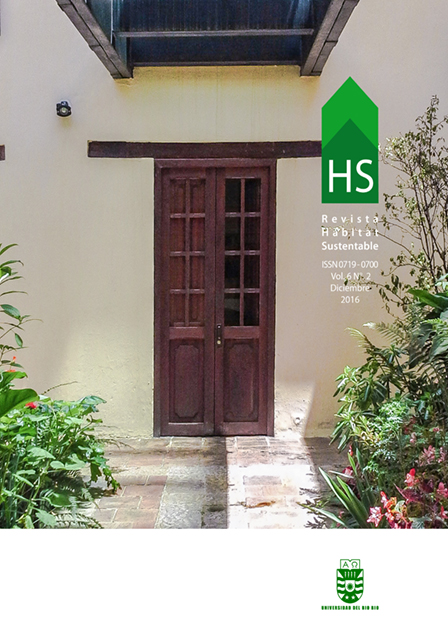The thermal performance of green roofs in arid cities
Keywords:
green roofs, thermal behavior, water demand, plant varietiesAbstract
Green roofs are an urban greening strategy that mitigates the effects of global warming by reducing urban temperatures and energy consumption derived from indoor thermal conditioning used to achieve comfort conditions in summer. However, its implementation in arid cities is dependent upon the use of plant species with low water consumption. This paper assesses the thermal performance of green roofs employing two species with different growth habits and water demand: Aptenia cordifolia and Sedum spectabile. To this end, meteorological variables were measured in experimental cells by data loggers during the 2015 summer season. The results show that green roofs reduce average interior temperature by 2 °C, thermal amplitude by 8 °C, and maximum temperature by 6 °C, while Differences between the species tested were insignificant (0.5 °C). These values reflect the thermal efficiency of green roofs and the need to increase the number of species studied in order to determine the different benefits from species with low water consumption and high local availability.
Downloads
References
ALEXANDRI, Eleftheria y JONES, Phil. Temperature decreases in as urban canyon due to green walls and green roof in diverse climates. Building and Environment-Elsevier, 2008, nº 43, pp.480-493.
BÓRMIDA, Eliana. Mendoza, modelo de ciudad oasis. Revista SUMMA, 1986, nº 226, pp. 68-72.
CAMERON, Ross W. F., TAYLOR, Jane E. T. y EMMETT, Martin R. What’s ‘cool’ in the world of green façades? How plant choice influences the cooling properties of green walls. Building and Environment, 2014, nº 73, pp. 198-207.
CANTÓN, María Alicia y FERNÁNDEZ Jorge. Efecto de los toldos en las condiciones térmicas del espacio abierto y su influencia en los interiores en zonas áridas. Energías Renovables y Medio Ambiente. 2010 nº 26, pp. 1-8.
CLARCK, James R. y MATHENY, Nelda P. A model of Urban Forest Sustainability: Application to Cities in the United States. Journal of Arboriculture. 1998. March, vol. 24, nº 2, pp. 112 a 120.
DI RIENZO, Julio A., CASANOVES, Fernando, BALZARINI, Mónica G., GONZALEZ, Laura, TABLADA, Margot y ROBLEDO, Carlos Walter. InfoStat versión 2015 [en línea] Grupo InfoStat, FCA, Universidad Nacional de Córdoba, Argentina. Disponible en http://www.infostat.com.ar
FLORES ASIN Juan Emiliano, MARTINEZ Claudia Fernanda y CANTÓN María Alicia. 2013. Tecnologías verdes. Potencial de aplicación en el área metropolitana de MENDOZA (AMM). En: Acta de la XXXVI Reunión de Trabajo de la Asociación Argentina de Energías Renovables y Medio Ambiente (22 al 25 de Octubre de 2013). Tucumán, Argentina, 2013.
JAFFAL, Issa, OULDBOUKHITINE, Salah-Eddine y BELARBI, Rafik. A comprehensive study of the impact of green roofs on building energy performance. Renewable Energy-Elsevier, 2012, nº 43, pp. 157-164.
KLEIN, Petra M. y COFFMAN, Reid. Establishment and performance of an experimental green roof under extreme climatic conditions. Science of the Total Environment-Elsevier, 2015, nº 512-213, pp. 82-93.
LA ROCHE, Pablo. Low Cost Green Roofs for Cooling: Experimental series in a hot and dry climate. En: PLEA2009 (22-24 June 2009) - 26th Conference on Passive and Low Energy Architecture. Quebec City, Canada, 2009
QIU Guo-yu, LI Hong-yong, ZHANG Qing-tao, CHEN Wan, LIANG Xiao-jian y LI Xiang-ze. Effects of Evapotranspiration on Mitigation of Urban Temperature by Vegetation and Urban Agriculture. Journal of Integrative Agriculture, 2013, nº 12, pp. 1307-1315.
SAVIO, Peter., ROSENZWEIG Cynthia., SOLECKI William D., SLOSBERG, Ronald B. Mitigating New York City’s Heat Island with Urban Forestry, Living Roofs, and Light Surfaces. New York City Regional Heat Island Initiative. The New York State Energy Research and Development Authority, Albany, NY, 2006.
Downloads
Published
How to Cite
Issue
Section
License
The content of articles which are published in each edition of Habitat Sustentable, is the exclusive responsibility of the author(s) and does not necessarily represent the thinking or compromise the opinion of University of the Bio-Bio.
The author(s) conserve their copyright and guarantee to the journal, the right of first publication of their work. This will simultaneously be subject to the Creative Commons Recognition License CC BY-SA, which allows others to share-copy, transform or create new materials from this work for non-commercial purposes, as long as they recognize authorship and the first publication in this journal, and its new creations are under a license with the same terms.











 Scientific Information Program/Concurso Fondos de Publicación de Revistas Científicas 2018/ Proyecto Mejoramiento de Visibilidad de Revistas UBB (Código:FP180007).
Scientific Information Program/Concurso Fondos de Publicación de Revistas Científicas 2018/ Proyecto Mejoramiento de Visibilidad de Revistas UBB (Código:FP180007).





